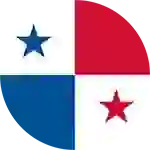Panama
-- Republic of Panama --
Panama officially Republic of Panama , is the southernmost country of Central America and the whole of North America. Situated on the isthmus connecting North and South America, it is bordered by Costa Rica to the west, Colombia to the southeast, the Caribbean to the north and the Pacific Ocean to the south. The capital is Panama City. At the time of the arrival of the Spanish in the 16th century, the known inhabitants of Panama included the Cuevas and the Coclé tribes. These peoples nearly disappeared, above all, from European infectious diseases to which they had no immunity. The Isthmus of Panama was formed about 3 million years ago when the land bridge between North and South America finally closed, after which plants and animals gradually crossed it in both directions. The existence of the isthmus had an impact on the dispersal of people, agriculture and technology throughout the American continent from the appearance of the first hunters and collectors to the era of villages and cities. Prior to the arrival of Europeans, Panama was widely settled by Chibchan, Chocoan, and Cueva peoples, among whom the largest group were the Cueva (whose specific language affiliation is poorly documented). There is no accurate knowledge of the size of the indigenous population of the isthmus at the time of the European conquest. Estimates range as high as two million people, but more recent studies place that number closer to 200,000. Archaeological finds as well as testimonials by early European explorers describe diverse native isthmian groups exhibiting cultural variety and suggesting people already conditioned by regular regional routes of commerce.
-- Economy --
According to the CIA World Factbook, as of 2011 Panama had an unemployment rate of 2.7%.A food surplus was registered in August 2008. On the Human Development Index Panama was ranked at number 60 (2008). In recent years, Panama's economy has experienced an economic boom, with growth in real gross domestic product (GDP) averaging over 10.4% from 2006–2008. The Panamanian economy has been among the fastest growing and best managed in Latin America. Latin Business Chronicle has predicted that Panama will be the fastest growing economy in Latin America in the five-year period 2010–14, matching Brazil's 10% rate. Like most countries in the region, Panama is feeling the impact of the global financial crisis, which threatens to undermine the social gains made in the past few years. The expansion project of the Panama Canal, combined with the conclusion of a free trade agreement with the United States, is expected to boost and extend economic expansion for some time.
Panama's economy, because of its key geographic location, is mainly based on a well developed service sector heavily weighted towards banking, commerce, tourism, and trading. The handover of the Canal and military installations by the United States has given rise to large construction projects. Tourism in the Republic of Panama is rapidly growing. Tourism in Panama kept its growth during the past 5 years due to the government offering tax and price discounts to foreign guests and retirees. These economic incentives caused Panama to be regarded as a relatively good place to retire in the world.
The Panamanian currency is officially the balboa, fixed at parity with the United States dollar since independence in 1903. In practice, however, the country is dollarized; Panama has its own coinage but uses U.S. dollars for all its paper currency. According to the Economic Commission for Latin American and the Caribbean, Panama's inflation as measured by weight CPI was 2.0% in 2006. Panama has traditionally experienced low inflation, as it shares currencies with the U.S. The high levels of Panamanian trade are in large part from the Colón Free Trade Zone, the largest free trade zone in the Western Hemisphere. Last year the zone accounted for 92% of Panama's exports and 64% of its imports, according to an analysis of figures from the Colon zone management and estimates of Panama's trade by the United Nations Economic Commission for Latin America and the Caribbean. Panama's economy is also very much supported by the trade and exportation of coffee and other agricultural products.
-- Politics --
Panama's politics take place in a framework of a presidential representative democratic republic, whereby the President of Panama is both head of state and head of government, and of a multi-party system. Executive power is exercised by the government. Legislative power is vested in both the government and the National Assembly. The judiciary is independent of the executive and the legislature.
For all people national elections are universal and mandatory for all citizens 18 years and older. National elections for the executive and legislative branches take place every five years. Members of the judicial branch (justices) are appointed by the head of state. Since the U.S. invasion and the end of the 21-year military dictatorship, Panama has successfully completed four peaceful transfers of power to opposing political factions. Panama is divided into ten provinces, with their respective local authorities (governors) and has a total of ten cities. Also, there are five Comarcas (literally: "Shires") populated by a variety of indigenous groups.
-- Trade in Panama --
Major exports of Panama : Antibiotics (17%), Cruise ships and similar vessels for the transport of persons (12%), Medicaments, packaged (7%), Petroleum oils, refined (5%), Petroleum oils, crude (5%)
Major imports of Panama : Cruise ships and similar vessels for the transport of persons (53%), Petroleum oils, refined (7%), Petroleum oils, crude (5%), Medicaments, packaged (2%), Cars (1%)
Major trade partners of Panama (Exports) : United States (20%), Ecuador (10%), Venezuela (8%), Korea, Rep. (5%), Guatemala (4%)
Major trade partners of Panama (Imports) : Chile (33%), Argentina (27%), Venezuela (12%), United States (9%), Brazil (8%)


